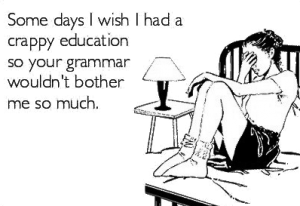Use
The Prioritization of Rules
An important source of frustration in the study of language is the absence of a rigorous application of the grammatical rules that we are taught. This absence of rigor can be blamed on neither the student, nor the teacher who both generally wish that the rules of grammar were more like those of mathematics — consistent and reliable. This is, however, not the case, for one can nearly always discover an exception. Accordingly, each time a student learns a new rule of grammar and believes that he has mastered its use, he is confronted with an exception to the rule that shakes his confidence about what he already knows.

The aforementioned irregularity is a common feature of all languages and should be anticipated — not bemoaned. For, in the end language is very much like open source software that can be created by anyone, used by everyone, and is best maintained by those who have a vested interest in its continued existence — nearly everyone who uses it! In principle, and often in practice, there is no freer social institution than language.1 Yes, there are those who seek to dictate proper use, but inevitably they fail, for there is no rule of language that is not determined by convention; people simply agree on what is best use for them. For, each realizes that without this agreement the open source software of human language will quickly become extinct, and the effort that went into its creation will have been for naught. After all, of what use is a set of code rules, if no one abides by them?
This does not mean, however, that the rules cannot change. For, change they do. New rules are added, and old rules are made obsolete, if enough people find value in making the changes. What validates grammatical and morphological rules across time are the people who use them. What causes them to change are numerous and varied. Important is that every new rule is based on the rules already in place, and that the preexisting rules themselves often lack logical consistency and tend to vary within the context that they are used. As a result, both language learner and teacher should not only expect exceptions to the rule, but they should embrace and learn how to prioritize them, so as to express and understand best the conceptual logic of the sender’s message.

In effect, rarely should the words always and never be used in reference to grammatical and morphological rules; rather, the words preferred and discouraged should be utilized.
Each new rule to which a student is introduced should be introduced as a convention of best practice — not, as a fast rule that should never be broken. This is especially true of literary text in which writers are prone to take liberties that most users of the language do not. Keep in mind, those who make the greatest use of a language are likely to understand its logical inconsistencies best, and are thus likely to be an important source of innovative change. Not only do they understand the language well, but also their audience for whom they write and speak. They know what the convention will bear and what it will not.
In the English language there is no better example of the need for prioritization than the use of the definite and indefinite articles. Indeed, it is not enough to teach the rules that govern their use — if this is even very well done in the first place –, but also how to prioritize the rules according to the sender’s message and the receiver’s understanding of it.
Style
The Liberty of Use
What is more, many senders (speakers/authors) cultivate their own style — i.e., they use only a portion of the convention and add some nuance to it that makes them different. Intuitively, they understand that language is the property of the user, a collective good in which everyone owns a share and has a voice in its determination.
In effect, mastery of a language is never complete, even though we are able to reach the same level of comfort in a second language that we have in our first-language. That level of comfort is not, however, unilateral. For, each time we stumble in a communication someone or something is to blame. As we tend to blame each other before we blame our surroundings, it is the person who has acquired the language of the communication as a second-language, who is first to blame. And, if he is not better, or at least equally versed, in the conventions of the language, he is likely to correct himself. This, in effect, is an advantage that second-language learners have over first-language masters; the former’s understanding of the language is explicit, whereas the latter’s is merely implicit and not always well understood. Never forget that each of us learns his first tongue in his own way and in accordance with the social environment in which he is brought up, and uses that are acceptable in one community may not be acceptable among the majority of users.

In the end, none of us knows, or could possibly ever know, all there is to know about a language. Rather, each of us acquires that part of the convention (the grammatical and morphological rules that make each language different from every other) that services his own purposes well. Further, those who demand to be understood by everyone must restrict their use of convention to the lowest possible denominator. Accordingly, the individual style of a speaker or author can only be as valid as the audience whom he cultivates permits. There are few things in this world that celebrate simultaneously the individual and collective better than language.2
Then too, there are those in government who believe that the collective belongs to them and would impose their own conventions.
- A definition of open source software offered by techterms.com that explains how the software is created, used, and maintained. ↩
- The statue of the Fontaine du Petit Julien dates back to the 15th century, but its origin is obscure. The statue was originally carved in stone and replaced with a bronze replica sculpted by Jérome Duquesnoy in 1619. The statue visible today at the intersection of the La rue du Chêne and La rue de l’Étuve in Bruxelles is not the original bronze statue. This latter is currently housed in the municipal museum for safer keeping. The statue is the pride and joy of the city’s inhabitants. ↩
